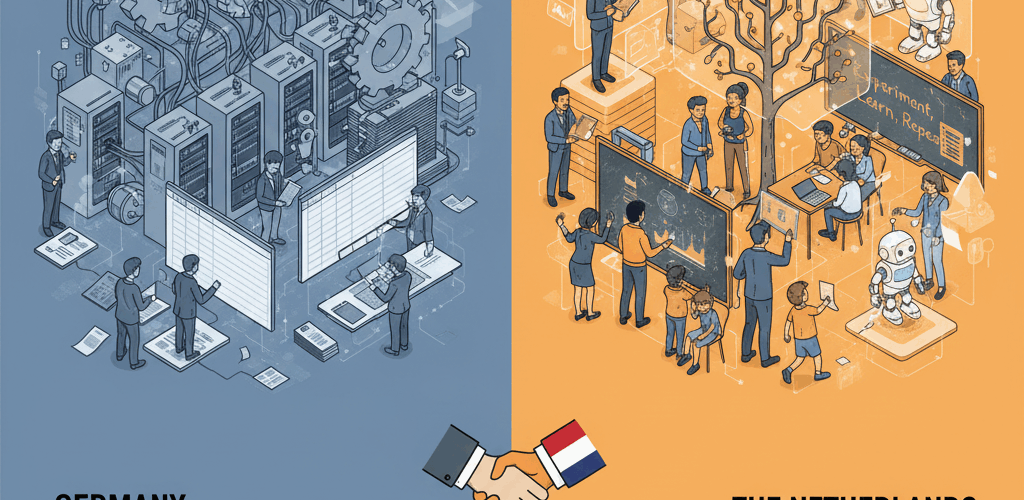EN
DE
NL
A product is never finished — and neither is a culture.
That’s the sentence that came to my mind while reading yet another report on AI adoption in Germany and the Netherlands.
Both countries invest heavily in digital transformation, but the outcome couldn’t be more different.
Germany: Structured, Funded… and Stuck
Germany has the money, the research, and the ambition — yet somehow, it still struggles to apply what it knows.
The country invested 5 billion euros in AI initiatives until 2025, launched “AI action plans,” and is even building a massive GPU gigafactory to compete with the global tech players.
But here’s the paradox: most of this energy gets lost in a maze of bureaucracy and parallel projects.
Research is excellent. Implementation? Slow.
The political language is full of buzzwords — ecosystem, innovation, transparency — but the lived reality inside most organizations still runs on hierarchies, Excel sheets, and cautious committees.
And while regulation and risk avoidance dominate the mindset, other nations are already designing AI-driven public services and adaptive workplaces.
The Netherlands: Experiment, Learn, Repeat
In contrast, the Netherlands took a quieter but smarter route.
They didn’t start with a “national strategy.” They started with education.
Since 2014, schools across the country have been teaching digital literacy and AI ethics.
AI and automation are part of everyday learning — not a future skill, but a present one.
The Dutch approach is pragmatic: small-scale pilots, cross-sector collaboration, and trust-based experimentation.
Brainport Eindhoven — the hub around ASML, Philips, and top universities — acts as a living lab for applied AI and Industry 4.0.
The result?
When Germany debates, the Netherlands prototypes.
When Germany regulates, the Netherlands collaborates.
Two Different Mindsets
| Dimension | Germany | The Netherlands |
|---|---|---|
| Mindset | Risk management | Opportunity management |
| Culture | Technocratic, procedural | Experimental, human-centric |
| Implementation | Fragmented, slow | Connected, agile |
| Governance | Layered and political | Transparent and cooperative |
| Education | Top-down reform | Early integration & trust |
The Core Difference: Culture Before Code
Germany often treats AI like an engineering project.
The Netherlands treats it like a social learning process.
And that’s the real game-changer:
AI adoption is not a technological transformation — it’s a cultural one.
It requires courage to experiment, permission to fail, and leadership that builds trust as structure, not softness.
My Take: The Dutch Advantage
Having lived and worked in both countries, I can tell you:
Innovation doesn’t fail because people resist change.
It fails because organizations resist learning.
In the Netherlands, digital transformation feels human.
In Germany, it often feels administrative.
And that’s why Dutch companies integrate AI faster — not because they’re smarter, but because they’re freer.
Closing Thought
If Germany truly wants to lead in AI, it must first unlearn its love for control and rediscover its curiosity.
Because the future of AI won’t be built by those who manage it — but by those who play with it.
Source: Perplexity (German Language)https://www.perplexity.ai/search/vergleich-einsatz-von-ki-deuts-p7EZhYDATxOEquzFd6lWVA#1
